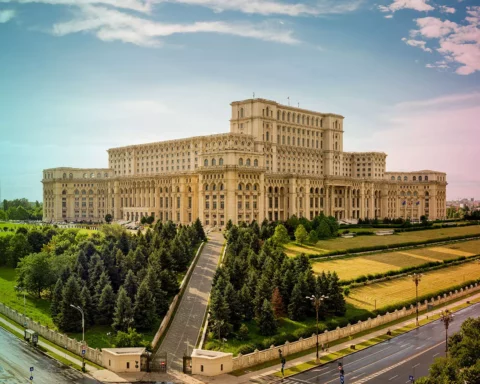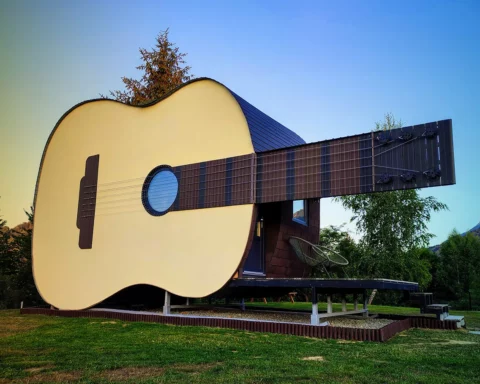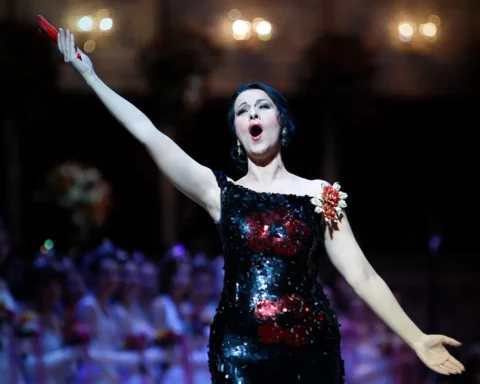Yes, yes – the must-see places are usually that many that we might soon need another term for the truly unique and unmissable destinations. The Three Seas Region offers many places that manifest outstanding beauty, historical value, and unmistakable cultural heritage. With such broad choices, it is not surprising that it might be difficult to go past the choosing stage. Fear not! We are coming to the rescue and providing you with our pick of 12 top places to visit in Central and Eastern Europe – one per each Three Seas Initiative state. But how to decide which one? Read on and check whether you would agree with our choices!
[smartslider3 slider=”15″]
Austria – Salzkammergut; Hallstatt
Salzkammergut must be one of the most picturesque areas in Austria. It has it all – mountains, lakes, bike routes, ski resorts, and places of unique cultural heritage. Parts of the region were enlisted as UNESCO World Heritage Sites. The area used to be a significant salt mining center, so salt mines come in as a bonus. It is in the name, really, as it translates from German as „the salt domain.”
The region’s main river – the River Traun – is one of the Danube’s tributaries and hence symbolically constitutes an additional connection to the other Three Seas States (the Danube is a waterway shared by several of them). Once you decide to arrive, there is plenty to see and do. But please, do not miss the small tourist-attraction village of Hallstatt. This postcard-worth charming little place is sure to steal your heart away. Its beauty is famous worldwide, which can be seen in the tourist-packed streets. In fact, it is so beautiful that it caused an international scandal. The Chinese decided to copy the site and built their version of Hallstatt in the Guangdong region of China. Sadly, they forgot to ask the Austrians whether they would be happy if they did so. Most of them weren’t… If you prefer a more intimate destination, we advise picking another place. Sankt Gilgen, perhaps?
Bulgaria – Veliko Tarnovo
Some claim that Veliko Tarnovo is the most beautiful town in Bulgaria. And with a great history. First declared Bulgarian capital during the Second Bulgarian Empire in 1185. This vouched for the town’s rapid development, which lasted until the end of the Empire in 1394. Today you can marvel at the medieval fortifications and old houses, where history is yours for grabs. The city is not just claiming the title – it was awarded the prize for the most beautiful city in Bulgaria several times.
It is also the cultural capital of the country. Romantically situated by the river and surrounded by fascinating natural wonders (such as caver), it represents what’s best about Bulgaria. If you have time to plan your trip, check when the next Sound and Light event is planned. During those shows, the town is illuminated and participates in a spectacle that attracts locals and tourists alike. There is also one other reason why Veliko Tarnovo is the best Bulgaria ambassador – one of its praised attractions is the miniature park „Mini Bulgaria,” where, in a matter of minutes, you can visit the most important monuments of the country. The latter recommendation is to be taken with a pinch of salt.
Croatia – Zadar
You might have expected to see Dubrovnik (Dalmatia’s pearl), Split, or one of the country’s wonderful islands. Zadar, however, has something about it that makes you fall in love with the place and never want to leave. Been there, done that! Located in the proximity of natural attractions and other sites of interest (for example – Nin), Zadar is a perfect base from where to take daily trips.
The city has a very welcoming atmosphere about it. It is full of charm, pleasantly teaming streets, lavishing the visitors with ancient monuments. Wandering aimlessly in the city is a pleasure on its own. The white cobblestones and walls provide shelter from the hot Croatian sun in the summer months. And you don’t need to look for something to see – Zadar provides entertainment in a delightful, effortless way. As a cultural hub, it is known for two unique installations by Nikola Bašić.
The first one, Water Organs, can be admired 24/7, but its location at the promenade near to port attracts people mainly in the daytime when they can rest, look at the water, enjoy the sun, and listen to the pleasant hum of the organs. In the nighttime, however, the same spot, several meters away, illuminates with the Monument to the Sun – a model of the solar system. It is hard to describe just how amazing it looks and feels to explore the planets by wandering around them in the dim colorful lights.
But it is an experience you are not likely to forget. If this is not convincing enough of why Zadar has made this list – let us throw in some fantastic beaches all in the area to make you better understand why it is this city that, in our eyes, deserves to represent the spirit of Croatia.
Czechia – Bohemian Switzerland
Of course, you could travel to Prague or Karlovy Vary (a famous Spa town). Still, we feel that Bohemian Switzerland provides visitors with a unique experience worth representing the country’s beauty. This mesmerizing region, located in the north of Czechia, became a National Park in 2000. A seabed thousands of years ago, it now lures visitors in with its enchanted forests, magical rocks, and sights as if taken straight from a fairy tale.
Best enjoyed during long walks that allow you to forget about your daily struggles and soak up nature’s wild beauty. The village of Hřensko. Located on the bank of the Kamienice River, tourists have visited it since the 19th century. The unique location of the settlement, in the river gorges, makes it a perfect place to start exploring the ancient-sea National Park. Some of the most famous sites of the Park are located in the vicinity of the village at a comfortable walking distance.
When planning to visit Czechia, you should consider going to Bohemian Switzerland. It is so unusual that it starred as one of the locations for filming The Lion, the Witch and the Wardrobe Narnia series. The most puzzling part is that this natural gem still needs to be frequented by as many tourists as its beauty suggests it should. But that’s the deal-maker piece of information for those who like the off-beaten-track, more authentic experience of the places they visit. And, of course, to those who would welcome an overabundance of selfie opportunities in the breathtaking scenery without the stressful presence of other tourists, breathing down your neck as they are impatiently waiting for their turn to auto-paparazzi.
Estonia – Saaremaa Island
From all the beautiful and out-of-the-ordinary Estonian sites, Saaremaa is their best representative. The largest of Estonia’s islands, also known as „the Pearl of the Baic States,” it has gathered everything you could possibly want to see on just 2,674 kilometers squared. Fancy a sea spa? Kuressaare has the highest number of spas per person in the world.
A castle? There you go – the same town is home to a 14th-century castle, also, incidentally, the best-preserved fortress of the Baltic States. Something iconic? Turn your steps towards the Sõrve Lighthouse or the Angla Windmill Park to take those needed Instagram shots. Wild nature? How about a bird sanctuary in the Vilsandi National Park? Created in 1910, it is the oldest protected natural area in the Baltics. Saaremaa has even got a meteorite crater field for you to explore! The Kaali Crater is pretty impressive for this part of the world. Culture-wise, the island offers many artisan shops and is known for great restaurants. Specialty? Seafood, of course! And some locally brewed beer. No question about it – the island can keep you entertained for several days, as it provides an authentic Estonian experience to all who come to visit.
Hungary – Lake Balaton
Why are we suggesting Lake Balaton over all the other Hungarian attractions? Firstly, Hungary, the world’s capital of spas, doesn’t really have one of ‘the best’ locations for thermal-water-provided relaxation. Besides, the world’s largest thermal lake (Heviz) is situated not far from Balaton and the town of Keszthely. Pretty much everywhere you go, you shall find a decent spa offer in the vicinity.
The Badacsony wine region sits right at the banks of the lake, and anyway, famous vineyards and wines are also easy to find. And then again, Not that Balaton is difficult to spot – the nearly 600 kilometers square of water is a sight rather impossible to be overlooked. But it is precisely the size of this lake that provides a uniquely Hungarian experience as the reservoir compensates for the lack of sea access. The region of Balaton Lake is vast and varied, with the Balaton Uplands listed by Unesco as one of the World’s Heritage Sites.
Around the lake is a cycling route that can be enjoyed by those who prefer a more active way to unwind. Numerous castles will set your imagination spinning with the tales of long-gone knights and princesses. You can feast your eyes on some of the most beautiful Hungarian panoramas as you explore the region.
Latvia – Gauja National Park
Since about 50% of Latvia is covered with forests, it is only natural that the best place to go and visit should be found in the woods. And so it is. Gauja National Park, situated on the River Gauja, is one of the most unique destinations in Latvia and its oldest protected area. Let’s start from the basics – accommodation. Two little towns come highly recommended: Ligatne and Sigulda.
The former had a famous paper mill, and some of the most iconic buildings were used as dwellings for the mill workers. It also features a secret Soviet bunker that became a popular tourist attraction. Sigulda, on the other hand, features ruins of a medieval, post-Teutonic castle, as well as a nicely preserved 19th-century palace. The town is also famous for its bobsleigh track, a complex of ski-jumping hills, and Gutman’s Cave, complete with 16th-century inscriptions on the cave’s walls.
Not far from Sigulda, you can find Turaida Castle, romantically overlooking Gauja Park (and with a romantic legend up its sleeve). If you fancy a larger town to base yourself in, try Cēsis. This medieval settlement also features an impressive castle built by the Livonian Brothers of the Sword. It is also an important site of the Latvian War of Independence, with a decisive battle of 1919 taking place in the area. So if it is Latvia you want – head to the Gauja region, where you will not be disappointed.
Lithuania – Curonian Spit
Surprised? Lithuania is known for its vast forests, which cover 40% of the land, and we recommend you visit a bulwark of sand?! Hold on, for there is a method in this madness. The Curonian Spit is one of the prehistoric wonders of nature and a UNESCO World Heritage Site. The spit stretches for 98 kilometers, of which 53 lie within Lithuania’s borders. It combines the features of a perfect seaside resort and is a dream spot for nature enthusiasts, especially those into birdwatching (Nagliai Nature Reserve).
The area is protected and known as the Curonian Spit National Park. It treasures one of the biggest and best-preserved dunes in this part of Europe. Of them, the Pardanis Dune cannot be missed. Fifty-two meters high, it is the highest dune on the Curonian Spit. You can add 13,8 meters for the sundial situated at the top of the dune. Sadly, you cannot climb the structure. The dunes are in constant movement, and some swallowed entire villages that now rest beneath the surface of the sand. But it is not only the desert-like surroundings.
There are some places to stay and take a plunge into the best of what Lithuania has to offer. If you fancy a smaller area to stay, try Nida, Juodkrante, and Smiltyne. If, however, you are more of a city person, then Klaipeda, located at the gate to the Spit, shall be a perfect place to stay. This port city of German origins (historically known as Memel) has everything you could expect of a representative, significant historical center of any state. Undoubtedly, the Curonian Spit area will leave you pleasantly surprised and in love with Lithuania.
Poland – The Pieniny Mountains
Perhaps not the most obvious choice, but trust us – as a Pole, I had a fair chance to see some fantastic sites in my home country. However, despite living at the beautiful Polish seaside (sea and oceans being my preferred destination for any holiday), it is the Pieniny Mountains that, for some reason, spring immediately to my mind whenever I am to recommend one area to visit.
Why? Perhaps because they have got everything you could wish for: breathtaking views; iconic natural landmarks (like the Trzy Korony peak); centuries-old attractions (Dunajec rafting); welcoming, kind people; specialties of the local cuisine; and trails that take you through the core lands of the Polish Kingdom. These lands were once roamed by the Polish kings, queens, and knights, and many legends are hiding among spectacular, natural wonders.
Don’t be shy and drink some water from cristal-clear springs. You can, of course, buy the shop’s bottled varieties of the Kinga springwater, but better yet – discover where the brand took its name from. The Pieniny Mountains are situated right next to another beautiful (and larger) mountain chain – Beskidy, and nothing is stopping you from exploring a little further.
Probably the most famous towns of Pieniny are Krościenko nad Dunajcem and Szczawnica. Despite being tourist destinations, these small towns have much charm and do not give you the uncomfortable feeling of being drowned by the crowds. If you want to start discovering Poland (or perhaps think you know all about it), Pieniny is a destination you won’t regret.
Romania – Sibiu
A medieval town where houses have eyes. But let’s start at the beginning. Sibiu’s history reaches the 12th century. The heart of Sibiu beats in its 12th-century center. Divided into Upper and Lower Town, it is a maze of charming streets and colorful buildings you’d think are watching you. Before you start running away in horror, take another close look at those watchful rooftops and discover the feeling is down to the small windows fitted at the top of each building.
Apparently, their design results from a peculiar mix of Hungarian and German styles with a practical reason behind them – they kept the attics cool in hot weather. It is also a very record-breaking city. It was the European Capital of Culture in 2007; it was awarded the title of European Region of Gastronomy in 2019; then, in 2021, it was announced as the European Capital of Hiking. Just when you thought that’s all it is not. Sibiu is also the only city in Romania to have been given three Michelin stars of excellence. Does it really need any more recommendations?
Slovakia – Košice
Košice is the second-largest city in Slovakia, and – it has to be added – a very underrated one. With a sizeable cultural scene, it was chosen as the European Capital of Culture in 2013. The town showcases some of the best examples of Gothic and neo-Gothic architecture, as well as parts of medieval fortifications, art-nouveau cafes, and contemporary architectural gems. It is a good base for day trips (such as to the famous Spis Castle) and offers excellent exhibitions at local museums. The main street, Hlavna, is a strikingly beautiful and relaxed promenade. You can find a dancing fountain at one end in front of the National Theatre building. Please! Read on!
As much as these objects can be considered cheesy, this is different. I have seen a fair deal of ‘dancing’ water gulps during my travels. Still, the Košice version must be magical, as I found myself under its strong spell, involuntarily navigating towards it during my stay in this beautiful city. Equally in the daytime, but even more so after dusk, be warned not to get too comfortable around the fountain, as it tends to steal much more time than you’d expect to devote to watching it.
Though truth be told, even if you find yourself having lost an hour of your life, the immediate benefit comes in the form of utter relaxation. Please don’t take my word for it; check it out yourselves. I am sure that the fountain’s power shall win you over, and you will love it just as much as you grow to love this encaptivating city.
Slovenia – Maribor
Finally, we find ourselves in Slovenia, where we travel to Maribor. The town is the home to what is claimed to be Europe’s oldest vine, and indeed perhaps the oldest one in the whole world. Let us add – an alive and kicking vine, which still bears fruit. Its 400 years of age represent the longstanding history of winemaking in the region. Maribor offers many wine-connected attractions, such as a tour of the Old Vine House and the Vinag Wine Cellar – one of Europe’s oldest wine cellars. The tour is inclusive of a wine-tasting session.
At this point, all of the wine-loving travelers are sold on the idea of visiting Maribor, but there is so much more! The city’s Old Town and Lent district, situated at the bank of the Drava River, are one of the most romantic and picturesque destinations you can find. No wonder the city was named the European Capital of Culture in 2012. Numerous coffee shops invite you to sit down, relax, and soak up the atmosphere. Maribor is likened to the capital of the country, Ljubljana, and it is said to offer just as much entertainment yet at a slower pace.
It is here where you can immerse yourself in the day-to-day life of Slovenians, better understanding the country’s culture and nature. With the proximity of the Pohorje Mountains, Maribor is a great winter destination for a wallet-friendly skiing getaway. Before you leave, make sure to take in the panorama of this hidden jewel and climb Pyramid Hill. A little stroll up this man-shaped mound will leave you with memories to treasure forever.
We hope that you enjoyed browsing through our selection. It was no easy task to try and pick one, just ONE place from hundreds of exciting spots each of the Three Seas states offers. But every trip has to have its beginning somewhere. Do not confuse it with the destination. Once you begin, ‘destination’ becomes a fluid concept that separates you from the end of the trip. And that can be no easy point to reach since once you arrive at your initial destination, you notice it is immediately transforming into a new, exciting place you simply must visit before you depart. And the journey continues.






